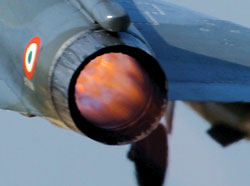INDIAN ARMED FORCES CHIEFS ON OUR RELENTLESS AND FOCUSED PUBLISHING EFFORTS

The insightful articles, inspiring narrations and analytical perspectives presented by the Editorial Team, establish an alluring connect with the reader. My compliments and best wishes to SP Guide Publications.

"Over the past 60 years, the growth of SP Guide Publications has mirrored the rising stature of Indian Navy. Its well-researched and informative magazines on Defence and Aerospace sector have served to shape an educated opinion of our military personnel, policy makers and the public alike. I wish SP's Publication team continued success, fair winds and following seas in all future endeavour!"

Since, its inception in 1964, SP Guide Publications has consistently demonstrated commitment to high-quality journalism in the aerospace and defence sectors, earning a well-deserved reputation as Asia's largest media house in this domain. I wish SP Guide Publications continued success in its pursuit of excellence.
- A leap in Indian aviation: Prime Minister Modi inaugurates Safran's Global MRO Hub in Hyderabad, Calls It a Milestone
- All about HAMMER Smart Precision Guided Weapon in India — “BEL-Safran Collaboration”
- India, Germany deepen defence ties as High Defence Committee charts ambitious plan
- True strategic autonomy will come only when our code is as indigenous as our hardware: Rajnath Singh
- EXCLUSIVE: Manish Kumar Jha speaks with Air Marshal Ashutosh Dixit, Chief of Integrated Defence Staff (CISC) at Headquarters, Integrated Defence Staff (IDS)
- Experts Speak: G20 Summit: A Sign of Global Fracture
Single Engine - Cost Benefits, Reliability, Thrust...

On every front, the SINGLE-ENGINE FIGHTER has proved itself at par during war-time operations and peace time manoeuvres—thereby tilting the scales in its favour and questioning the need for modern day fighters to come loaded with twin engines
Since the advent of the first-heavier-than air flying machine by the Wright Brothers, and thereon the aircraft’s evolution as a military fighting platform, the emphasis has been on speed, manoeuvrability and agility. The ‘Dog-fighters’ of yore, the bi/tri-planes of World War I or the monoplanes of World War II, had one thing in common: engine configuration. The prefix mono, bi and tri denoted single, double or triple wings—and not the power plants, as these were invariably singe-engine aircraft.
While engines were being continuously improved upon for greater power enabling more speed, faster rate of climb, service-ceiling, and so on, the single-engine configuration remained a favoured design parameter for the fighter aircraft. Twin/multi-engine configurations were essentially reserved for the lumbering bomber and transport aircraft. The post-World War II jet era heralded a large number of fighter/interceptor aircraft, such as the world renowned F-86 Sabre, F-100 Super Sabre and F-104 Star Fighter from the US, and the most numerously built fighter, the MiG-21, from erstwhile USSR. Differing greatly in various attributes, these had one thing in common: a single-engine configuration. English Electric Lightning was the only fighter developed in the 1950s with a twin-engine design, but it was not the most successful aircraft of the time. Phantom F-4 was perhaps the first widely acknowledged twin-engine design at a time when multi-role capability became a desirable attribute in a fighter aircraft.
Admittedly, multi-role capability has acquired pre-eminence as a design feature. However, does it require all modern day fighters to be loaded with twin engines? Not necessarily. Different nuances in operational capabilities dictate that any world-class air force would equip itself with a judicious mix of both single and twin-engine fighter aircraft to cater to all types of operational challenges. That said, the single-engine variety enjoys a distinct edge.
Safety and survivability of twin-engine aircraft both during peace (bird strikes and technical failures) and war (enemy action) have been quoted as the most important driving factors for such a configuration. First, looking at peacetime scenarios, advocates of twin-engine fighters themselves agree on the utmost degree of reliability of modern day jet engines. Take the case of the single-engine Mirage 2000 aircraft. Since its induction a quarter of a century ago, there has been no known case of engine failure causing the loss of a Mirage 2000 in the history of the Indian Air Force. Moreover, modern day engines are being made as bird-proof as possible. On the other hand, during war, the close positioning of engines in all modern aircraft designs would make the twinengine safety factor largely irrelevant if subjected to enemy action (say, for instance, if the engines’ compartment is hit by AAM/SAM weapons).
Proponents of the twin-engine theory also press their case by citing the need to compensate for the greater all up weight (AUW) of modern fighter aircraft that have to carry increasingly high fuel and weapon loads. While this theory may have carried some weight till recently, the argument is belied by Lockheed Martin’s recent production of the multi-role single engine F-35 Lightning II, Joint Strike Fighter. The single Pratt & Whitney F-135 engine at 25,000 lb st (dry) and 40,000 lb st (with reheat) produces as much thrust in both regimes as the combined thrust of power plants fitted on the twin-engine General Electric F-414 powered US F-18 Super Hornets, French Rafale with SNECMA M88 engines or the EADS’ Eurofighter Typhoon fitted with Eurojet EJ-200s—all state-of-the-art contemporary aircraft. At 27 tonnes, F-35’s AUW matches or exceeds that of the fighters described above.
The author has the distinction of having accumulated more than 5,000 hours on all types of aircraft, but mostly on single-engine fighters in the IAF. He was conferred gallantry awards in both 1965 and 1971 wars against Pakistan flying the Mystere and Su-7, respectively. Later, he commanded a squadron equipped with single-engine MiG-23 BN strike aircraft. The author also has the rare distinction of being the AOC-in-C of three major operational commands of the IAF.





